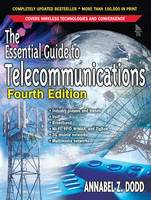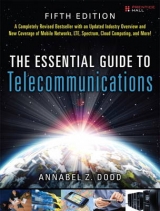
The Essential Guide to Telecommunications
Prentice Hall (Verlag)
978-0-13-148725-3 (ISBN)
- Titel erscheint in neuer Auflage
- Artikel merken
Leading consultant Annabel Dodd presents easy-to-understand, insightful
explanations of today's key trends and technologies: Industry Players and
Trends, Broadband, VoIP, Wi-Fi and WiMax, 3G Mobile Networks, and
Multimedia Networks. Previous editions have helped professionals worldwide
understand the major changes transforming the telecommunications industry.
In the past four years, the telecommunications industry has undergone major
changes. This is the complete guide to the new realities of telecommunications.
The new edition reflects all of today's most critical issues, trends, and
technologies. In addition to providing crucial insights into the fast-changing
competitive landscape, Dodd provides important information about the
structure of, and key players in, the industry.
Annabel Z. Dodd teaches courses on Wireless Mobile Services and Data Communications in the graduate program of Northeastern University's School of Professional and Continuing Studies. She also gives seminars to leading organizations. Formerly adjunct professor in the Master of Science in Technology Management program at SUNY Stony Brook, she was honored as Professor of the Year for 2000 by the Massachusetts Network Communications Council. The Essential Guide to Telecommunications has been translated into numerous languages, including Chinese, Japanese, and Russian. © Copyright Pearson Education. All rights reserved.
Preface
Acknowledgments
About the Author
I. FUNDAMENTALS AND VOICE OVER IP.
1. Basic Concepts.
The Transition to Digital
Analog Signals-Slower, More Prone to Errors
Digital Signals
Adding Meaning to Signals-Codes and Bits
A Byte = A Character
Baud Rate Versus Bits per Second-Electrical Signal Rates Versus Amount of Information Sent
Codes-Adding Meaning to Bits
Measuring Speed and Capacity
Broadband Service-Multiple Data Streams
Improving Utilization-Compression and Multiplexing
Compression-Shrinking Data to Send More Information
Multiplexing-Let's Share
Interoperability-Protocols and Architectures
Protocols-A Common Set of Rules
Architectures-How Devices Fit Together in a Network
Types of Networks-LANs, MANs, and WANs
LANs-Local Area Networks
LAN and WAN Devices-Higher Speeds, Lower Prices
Home LANs-Sharing High-Speed Internet Access
MANs-Metropolitan Area Networks . . . Links Within Cities
WANs-Wide Area Networks . . . Links Between Cities
Higher Speed Services for LAN Traffic
Carrier and Internet Service Provider Networks
Appendix
2. VoIP Systems, Circuit Switched PBXs and Cabling.
Telephone Systems-Voice over IP, PBXs, and Centrex Systems
What Is a Private Branch Exchange (PBX)?
IP PBXs for the Enterprise
Impetus for Change
Architecture of IP-Based Systems . . . How the Pieces Fit Together
Voice Quality and Security
Barriers to Acceptance of Voice over IP
Endpoints-IP Telephones Connected to Layer 2 Switches
PBX Trunks-Switch-to-Switch Connectivity
Demarcation-The Location at Which Telcos Wire Trunks
Circuit Switched PBXs-Proprietary Platforms
Centrex-Telephone Company Supplied Service
IP Centrex-Phone Companies Hosting Voice Over IP
Direct Inward Dialing-Bypassing the Operator for Incoming Calls
Key Systems-Multi-featured for Smaller Organizations
Hybrid PBX/Key Systems
Wireless Options for PBXs
Advanced Applications for Telephone Systems
Call Accounting-Billing Internal Departments
Call Detail Recording for Carriers-Generating Data for Billing
Voice Mail-Storing and Retrieving Messages
Voice Mail Components
Unified Messaging Integration of Voice Mail, Fax Mail, and E-mail
Unified Messaging Systems on the LAN
Multi-application Platforms in Carrier Networks
Speech Recognition
II. INDUSTRY OVERVIEW AND PUBLIC NETWORKS.
3. Industry Overview.
The Bell System after the 1984 Divestiture
Divestiture of the Bell System from AT&T in 1984
The Decline of AT&T
Independent Telephone Companies- Mostly in Rural Areas
The Emergence of Local Competition Prior to 1996
Competitive Access Providers (CAPs) to Bypass Access Fees
Uneven Competition for Local Telephone Service Throughout the U.S.
The Critical Nature of Facilities
Factors Leading to Passage of the Telecommunications Act of 1996
Wireless Services for Local Exchange Service-Spectrum Auctions
The Telecommunications Act of 1996
Universal Service Fund-Affordability and Availability
Post Telecommunications Act of 1996 Developments
FCC Rulings, Legal Challenges, and Progress Toward Deregulation
FCC Enforcement of Access to Local Networks after Bells Gain In-Region Long Distance
Impact of the Telecommunications Act of 1996
State of the Industry . . . Key Segments
Regional Bell Operating Companies (RBOCs) Post-1996 Mergers
Incumbent Local Exchange Carriers (ILECs)
Agents
Resellers
Wholesale Carriers-Carrier-to-Carrier Sales
CLECs-A Dwindling Industry Segment
CLECs-Local, Data, and Long Distance Services
Pending Purchase of AT&T and MCI-The Impact of Consolidation
Shrinking Numbers of Competitors-Financial Turmoil
What Went Wrong?
Intermodal Competition-Cable TV, Wireless, and Utilities
Cable TV Multiple Service Operators (MSOs)-Wired to the Max
Mobile Wireless Services
Utilities-The Third Pipe
Regulatory Issues
Unbundled Network Elements (UNEs)-Competitors Leasing Parts of RBOCs' Networks
The Impact of Higher Leasing Rates
Regulating Cable Modems-Cable, Information, or Telecommunications Services?
Voice Over IP-Regulatory Issues
Access Fees-A Shift in Balance Between Local and Long Distance Costs
Appendix
4. VoIP, the Public Switched Telephone Network, and Signaling.
Convergence in Public Networks
Circuit Switching-Network Inefficiencies and Convergence
Impediments to Adoption-Training, Embedded Assets, User Adoption, and Fear of the Unknown
VoIP Networks-Putting the Pieces Together
Softswitches-Standards-Based Platforms for Call Control
Media Gateways (Border Elements)-Switching and Interoperability Between Networks
Peer-to-Peer Music, Instant Messaging, Online Games, and VoIP
Outsourcing-The Role of IP
Voice Over Broadband for Residential Consumers
Voice Over IP Service in Homes
Customer Acquisition-Agents, Retail Outlets, and Amazon.com
Document Sharing and Online Webconferencing
Webconferencing to Share Documents
The Public Switched Telephone Network
Switched Services-Local and Long Distance Calling
Attributes of Real-Time Switching Services
Store-and-Forward Switching-Nonsimultaneous Sending and Receiving
"The Last Mile" or Access Networks
End and Tandem Central Offices
Wireless Local Loop-Low Customer Acceptance
Broadband Over Power Lines-Telephone Signals Over the Same Fiber that Carries Electricity
Carrier Hotels-Interconnecting Carriers and Providing Secure Space for Equipment
Interconnections Between Carriers-Transport
Signaling-The Glue that Holds the PSTN Together
Overview of Signaling-Uniform Signaling Developed by AT&T
Signaling System 7-Links Between Carriers
SS7 Components
5. VPNs and Specialized Network Services.
Virtual Private Networks-Remote Access and Interoffice Connections
Rationale for Virtual Private Networks Between Offices
Productivity Away from the Office-VPNs for Remote Access
Virtual Private Network Technology
Security-Firewalls, Protection Against Viruses, and Other Attacks
Frame Relay-A Shared Wide Area Network Service
Access to Frame Relay-56 Kilobits to T-3
Frame Relay to Access Other Networks
Frame Relay Service-Permanent Virtual Circuits and Committed Information Rate
Voice on Frame Relay-Instead of Private Lines
Dedicated, Private Lines
Dedicated Services-Wide and Metropolitan Area Networks
Network Topologies-How Sites Are Connected
T-1-24 Paths and T-3-672 Paths Over One Telephone Circuit
T-1: 1,544,000bps; E-1: 2,048,000bps Speeds
T-3, J-3, and E-3-North America, Japan, and the Rest of the World
A Fat Pipe for Data-Unchannelized T-1
T-1 Inefficiencies-Time Slots Running on Empty
CSU/DSUs-Digital Modems: Testing and Clocking
ISDN-Integrated Services Digital Network
Basic Rate Interface ISDN-Higher Usage in Europe and Japan Than the United States
Primary Rate Interface ISDN-23 Bearer and One Signaling Channel
NT1s and TAs: Modem-Like Devices for ISDN
Digital Subscriber Line (DSL)-An Interim Technology or a Vehicle for Video and IP?
The DSL Marketplace
Business Class DSL-Static IP Addresses
DSLAMs-Digital Subscriber Line Access Multiplexers
Television Over DSL Service-ADSL2+ and VDSL2
DSL-No Truck Roll; Self Service
Gigabit Ethernet
Ethernet Sales Channels
Challenges to Wider Deployment
Multiplexers Equipped with Reconfigurable Optical Add and Drop Multiplexers (ROADMs)
Ethernet Enterprise Service-Internet, VPN Access, and Private Lines
ATM-Asynchronous Transfer Mode
ATM's Speed Is Due to Three Characteristics
DSLAMs and ATM-Oversubscription
Mapping IP and Ethernet Traffic onto ATM
Elements of an ATM Network
SONET-Synchronous Optical Network
Optical Carrier (OC): North American; Synchronous Transport Mode (STM): International
SONET Rings-For Greater Reliability
Second Generation-Next Generation SONET
SONET with Dense Wavelength Division Multiplexing Capability
Third Generation SONET-Connectivity to Ethernet
SONET Offerings for Enterprises
Summary
Appendix
III. ADVANCED TECHNOLOGIES, CABLE TV NETWORKS, AND THE INTERNET.
6. Entertainment, Cable TV, and Last-Mile Fiber Systems.
Cable Multiple System Operators (MSOs)
Cable TV Architecture-Upgrades, Capacity, Speed, and Reliability
Cable TV Offerings
Set-Top Boxes-Interfaces to Satellite TV and Cable TV
Direct Broadcast Satellite TV-Reaching Customers Wirelessly
Broadcast, Over-the-Air Television
Towers-Terrestrial Wireless Transmissions
Affiliates-Transmitting Programming to Consumers
Digital Television-Less Spectrum Used, Improved Quality
Digital Cable TV-Lower Resolution Than HDTV
Digital TV Standards Worldwide
Digital Delivery-Entertainment over the Internet
U.S. Postal Mail with E-commerce for Movie Delivery
Digital Radio-Subscription Versus Advertising Support
HD Radio--High Definition Radio
Passive Optical Networking
PONs-Fiber to the Premises, Curb, Basement, or Neighborhood; FTTx
Passive Optical Network Standards
7. The Internet.
The Evolution of the Internet
UNIX, Telnet, and File Transfer Protocol
World Wide Web-Based on the Client Server Model
Internet Advisory Boards
Peering-To Exchange Data Between Carriers
ISPs: With Software Platforms for Enhanced Offerings
Hosting-Outsourcing Web Pages
Messaging and the Growth of Spam
Multimedia Attachments-Photographs, Movies, and PowerPoint
E-mail Formatted in HTML-Another Vehicle for the Spread of Viruses
Spam-Clogging Inboxes with Junk Mail
Interactivity Tools: Usenet, Chat, Mailing Lists, and Blogging
Internet Addresses
Registries-Management of Entire Top-Level Domains
Registrars-Assigning Domain Names to Organizations
Thirteen Root Servers Worldwide-The Basis for Internet Routing
Assignments of Numeric IP Addresses to ISPs and Carriers
Public and Private IP Addresses
Portals, Search Engines, and E-commerce
Portals-The Door to the Internet
Search Engines-Vehicles for Advertising Revenue
Electronic Commerce
Advertising on the Web-Instant Access to Offers
Popular E-commerce Sites
Privacy Concerns, Commerce, and National Security
Freedom of Speech, Access to Information, and Protection of Children
Intranets and Extranets
Intranets-Web Technology for Corporate Access
Extranets-Web Access for Customers, Partners, and Vendors
IV. WIRELESS SERVICE.
8. Mobile Services.
The Development of Cellular Networks
Cellular, Wireless, Cordless, and Mobile
Precellular Mobile Networks
First Generation Analog Cellular-Advanced Mobile Phone Services (AMPS)
Second Generation Digital Mobile Air Interfaces
Spectrum and Rights to Airwaves
Frequency
Ranges of Frequency-Spectrum Blocks
Spectrum Caps-Limiting the Amount of Spectrum Per Carrier
Allocation
Implication of Spectrum Ranges
Spectrum for Higher-Speed 3G Services
Unlicensed Spectrum for 802.11 and WiMAX
Multiband Versus Multimode
Mobile Carriers
The United States
Europe
China
India
The Structure of Second Generation Digital Mobile Networks
A Cell Site-Connections Between Customers and Mobile Networks
Switching and Signaling
Coverage Gaps-Rural Locales, Inside Buildings, and Congested Metropolitan Areas
Number Portability-Wireless to Wireless and Wireline to Wireless
Roaming Using Mobile Devices in Other Networks
Push-to-Talk-Mobile Walkie-Talkie Service
Enhanced 911
The Criticality of Mobile Networks-Emergency Preparedness
Evolving to Third Generation Packet Networks
Comparing Third Generation Technologies
The Transition to WCDMA-GPRS and Then EDGE
WCDMA-Wideband Code Division Multiplexing
The Evolution to CDMA2000 1X (Voice and Data) and CDMA2000 1xEV-DO (Data Optimized-High Data Rate)
3G Compatible Handsets-Multimode Capabilities for Roaming
The Path to IP Converged 3G Networks
802.20: IP Mobile Broadband Wireless Access-MobileFi
Mobile Networks for Video-Using Incompatible Technologies
Mobile Commerce, Enhanced Services, and Operating Systems
The Battle for Operating System Dominance
Camera Phones
Ring-Back Tones-Mobile Music Instead of Ringing
Mobile Commerce-Mobile Devices to Make Purchases
The IP Multimedia System and Interoperable Multimedia
3G Applications for Enterprises
Specialized Mobile Radio-Slow-Speed Packet Data and Push-to-Talk
Specialized Mobile Radio-Packetized Data Networks for Two-Way E-mail and Field Services
Satellites and Paging
Satellite Networks
Satellite Telephones-For Emergencies and Remote Areas
VSAT Service-Small Satellite Dishes
Paging Services
9. Wi-Fi, Wireless Broadband, Sensor Networks, and Personal Area Networks.
802.11 Wireless Local Area Networks (WLANs)
The Terms 802.11, WLAN, and Wi-Fi
The Criticality of Standards
The Main Standards: 802.11a, 802.11b, and 802.11g
802.11n-Improving Range (Area Covered), Capacity, and Data Rates
WLAN Infrastructure: Access Points and Switches
In Enterprises
Hotspots-Wi-Fi Inside Public Places
In Homes-To Avoid Running Cables
Wi-Fi Networks for Voice Over IP (VoIP)
Managing Security on WLANs
Compared to 3G: Mobility, Coverage, and Data Rates
Broadband Wireless Access
WiMAX: Broadband Access, Based on 802.16
Adapting 3G for Wireless Broadband Access: UMTS TDD and WCDMA
Personal Area Networks (PANs)
Bluetooth
Radio Frequency Identification (RFID)
Ultra-Wideband-High-Speed, Short Distance Links
Sensor Networks-The 802.15.4 Standard
ZigBee-A Protocol For Sensor Networks
Appendix
Glossary.
Bibliography.
Index.
| Erscheint lt. Verlag | 14.7.2005 |
|---|---|
| Verlagsort | Upper Saddle River |
| Sprache | englisch |
| Maße | 233 x 178 mm |
| Gewicht | 987 g |
| Themenwelt | Mathematik / Informatik ► Informatik ► Netzwerke |
| Technik ► Nachrichtentechnik | |
| ISBN-10 | 0-13-148725-6 / 0131487256 |
| ISBN-13 | 978-0-13-148725-3 / 9780131487253 |
| Zustand | Neuware |
| Informationen gemäß Produktsicherheitsverordnung (GPSR) | |
| Haben Sie eine Frage zum Produkt? |
aus dem Bereich



